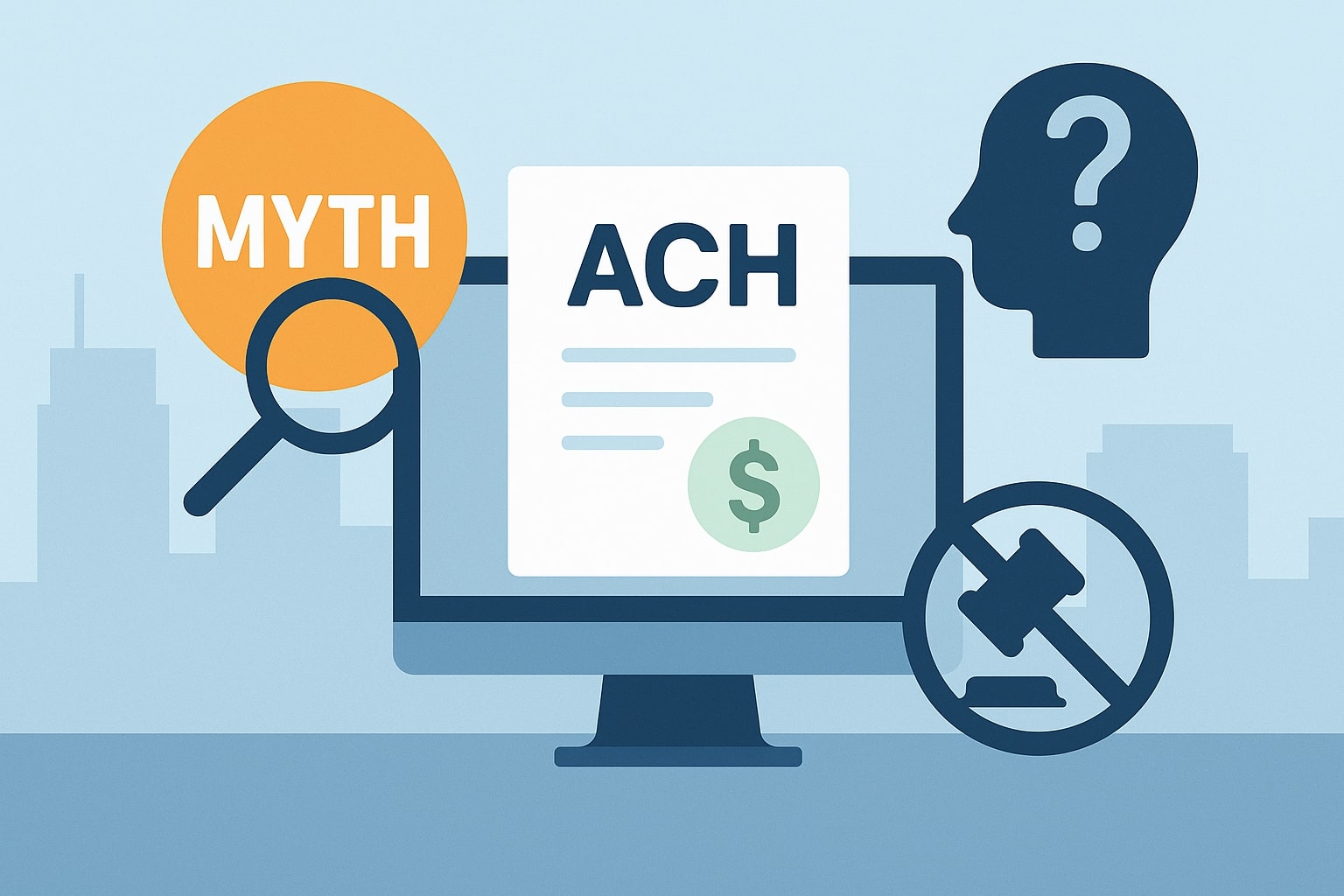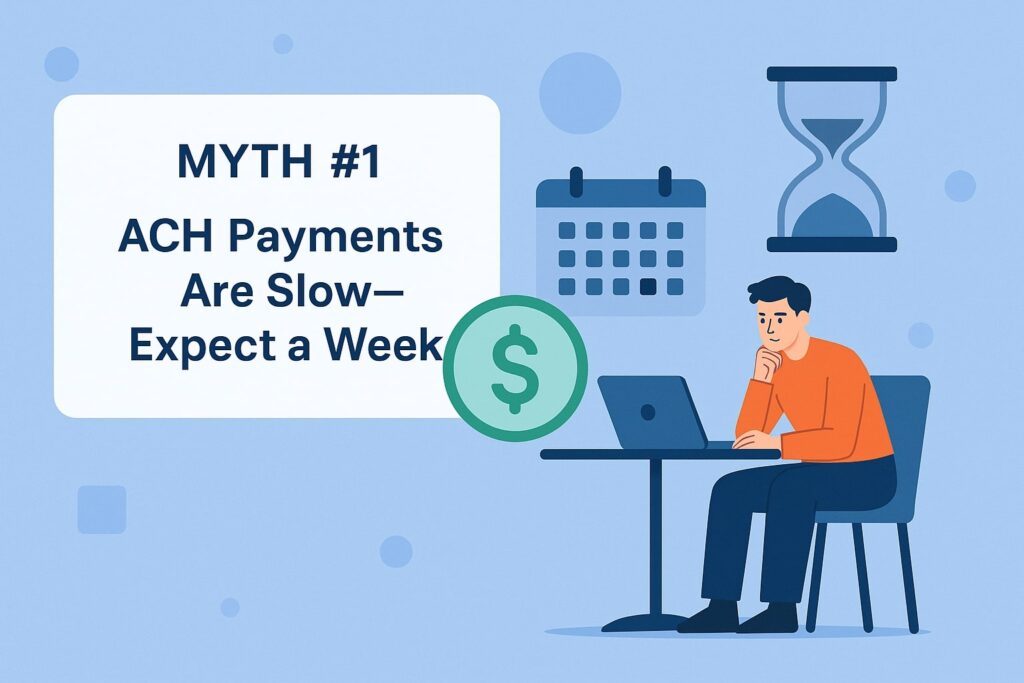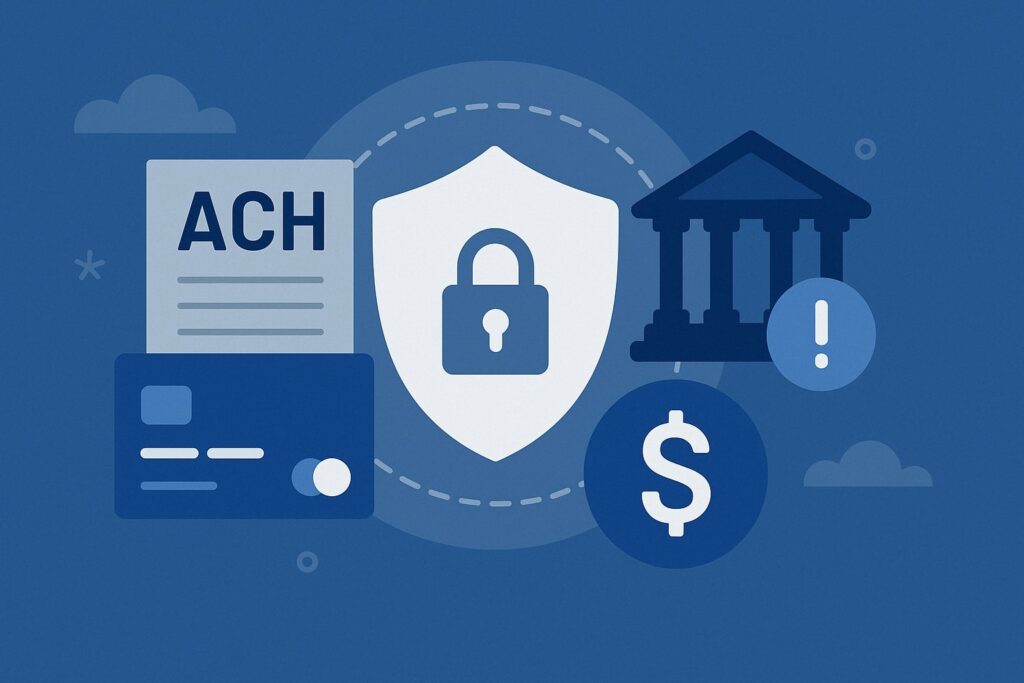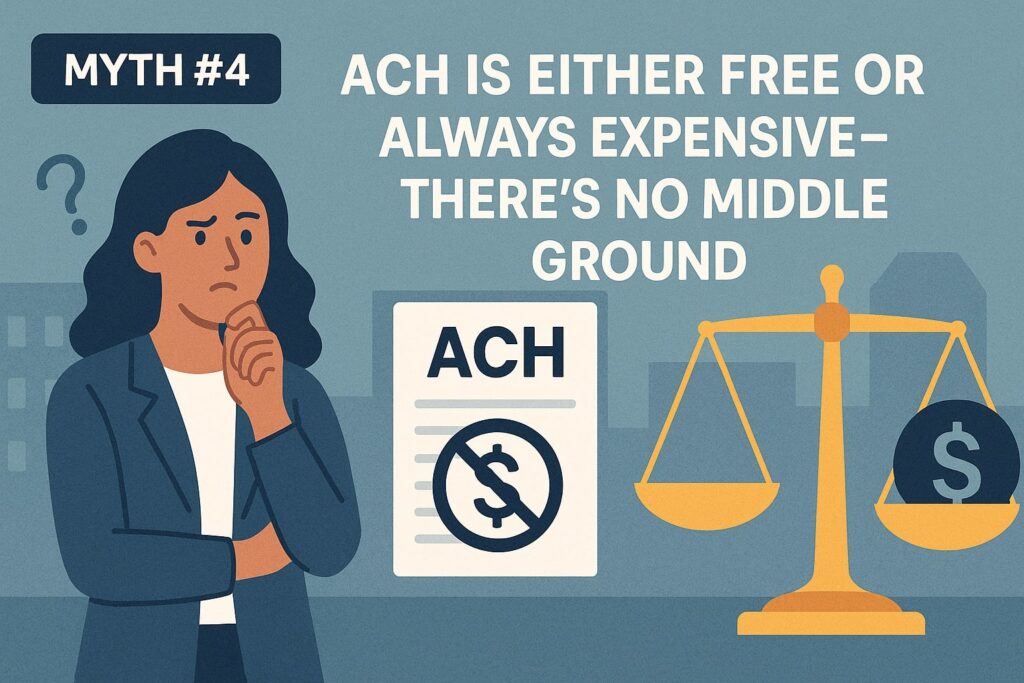
By achforbusiness October 21, 2025
ACH payments sit at the heart of how money moves between U.S. bank accounts. Yet for many owners, operators, and finance teams, misinformation keeps them from using ACH payments to cut costs, speed up cash flow, and delight customers.
In this guide, we unpack the most persistent myths about ACH payments and replace them with practical, plain-English truth. You’ll learn how ACH payments actually work, what timing you can count on, how risk and security are handled, how pricing is structured, and when ACH payments are the best fit compared with real-time rails, cards, and wires.
Every section is written for a U.S. audience and emphasizes clear steps you can use today—whether you run a solo consultancy, a SaaS startup, a medical practice, a nonprofit, or a national B2B distributor.
Myth #1: “Ach Payments Are Slow—Expect A Week.”

For years, people assumed ACH payments were synonymous with waiting. That belief made sense when you mailed paper checks or relied on batch windows that ran only once a day. But modern ACH payments no longer mean week-long delays.
In practice, most ACH payments clear and post within one to three business days, and Same Day ACH gives you multiple settlement windows on the same business day.
When you combine predictable cut-off times, bank-holiday calendars, and clearly labeled submit windows, ACH payments become a reliable, scheduled way to move funds.
For recurring billing, payroll, rent collection, tuition, vendor invoices, retainers, and B2B settlements, ACH payments usually beat checks and often rival card settlement speed after fees and reserves.
Two sources of confusion fuel the “slow” myth. First, some banks apply risk holds for new accounts or unusually large first-time transfers; that’s a bank policy, not a property of ACH payments.
Second, weekends and federal holidays pause banking days, so a Friday-afternoon debit may not appear until Monday or Tuesday. That’s about calendar math, not system slowness.
With a knowledgeable processor, clear scheduling, and features like Same Day ACH, your business can plan ACH payments with confidence, shorten your order-to-cash cycle, and reduce follow-up work on receivables.
How To Make Ach Payments Feel Fast In The Real World
Speed with ACH payments comes from process. First, submit debits early in the day to hit that day’s processing window. If cash flow matters, use Same Day ACH for high-priority items and standard ACH for everything else.
Second, build “funds availability” expectations into your invoices and contracts: for example, “ACH payments initiated by 2 p.m. ET post the same day when eligible.”
Third, encourage customers to approve recurring ACH payments so your debits land on consistent business days rather than drifting into weekends or holidays. Fourth, ask your processor to enable prefunding logic or risk-based limits that match your volume.
Finally, use automated reminders and clear remittance details so customers approve or authorize promptly. When you combine timing discipline with automation, ACH payments feel reliable and fast, not slow.
Myth #2: “Ach Payments Aren’t Secure.”

Another misconception is that ACH payments are less secure than cards or wires. In reality, ACH payments run on bank-to-bank rails governed by well-defined rules, standardized return codes, and strict authorization requirements.
The security model focuses on strong authorization, encryption in transit, tokenization of bank data, and fraud controls like account validation and risk scoring.
Unlike paper checks—which expose routing and account numbers—modern ACH payments allow you to collect bank info through tokenized, encrypted flows that never reveal raw numbers to your staff.
Add multi-factor authentication, IP reputation checks, and velocity limits, and ACH payments deliver robust, layered protection.
It’s also important to separate “security” from “settlement finality.” ACH payments are reversible in specific scenarios through established return codes, which is a consumer-friendly safeguard and a merchant risk to be managed.
That doesn’t make ACH payments insecure; it makes them governed. With well-designed authorization language, proper Standard Entry Class (SEC) codes, and fraud monitoring, you reduce both exposure and false positives.
For sensitive industries—healthcare, legal services, membership dues, education—ACH payments are often the safest way to move larger amounts without exposing card numbers or mailing checks.
A Practical Security Checklist For Ach Payments
Start by collecting authorizations in writing or via compliant online forms aligned to your use case (WEB for online consumer debits, PPD for consumer paper authorizations, CCD/CTX for B2B).
Use bank-account validation at onboarding—either micro-deposits or instant validation via secure bank login—to cut typo risk and detect closed or risky accounts. Tokenize bank data so your systems never store raw numbers.
Turn on anomaly detection: velocity alerts, limits by customer, device fingerprinting, and geolocation signals. Enforce least-privilege access for staff who view reports. Use secure file transfer (SFTP or API with TLS) for any batch uploads.
Finally, set clear ops playbooks for returns such as R01 (Insufficient Funds), R02 (Account Closed), or R10 (Unauthorized), including how to contact customers and when to switch to card or wire for follow-up.
Myth #3: “Ach Is Only For Payroll Or Big Enterprises.”

Historically, many small businesses saw ACH payments as a “big company” tool for payroll, utilities, or government payments. That’s outdated. Today, ACH payments help U.S. freelancers, sole proprietors, local service companies, professional firms, and eCommerce brands lower costs and stabilize cash flow.
If you send invoices, collect retainers, run subscriptions, or get paid for large B2B orders, ACH payments likely save you substantial card fees and reduce disputes tied to card expirations or chargebacks.
ACH payments also fit perfectly for membership clubs, property managers, home-services, clinics, wholesalers, and nonprofits that depend on recurring donations.
Why the shift? Two reasons. First, modern platforms make ACH payments as easy as cards—customers click a link, pick their bank, and authorize.
Second, economics is compelling. Flat fees or capped percentages make ACH payments dramatically cheaper at high ticket sizes.
Pair that with automated retries for insufficient funds and clear reconciliation files, and ACH payments become a daily tool for the smallest organizations. From $30 gym dues to $30,000 commercial orders, ACH payments scale without your margins getting squeezed.
High-Impact Use Cases For Small And Midsize Businesses
If you invoice clients monthly, add an ACH payments option with a small discount for choosing it. If you sell big-ticket B2B items, present ACH as the primary option and cards as a convenience alternative.
If you run a subscription, enable recurring ACH payments and collect one-time card details as backup. For seasonal businesses, use ACH payments for deposits, milestone invoices, and final balances to keep card interchange from eroding profits.
Property managers can pair ACH payments with tenant portals and automatic reminders. Nonprofits can promote ACH for sustaining donors to reduce card churn. Each of these patterns lowers acceptance costs and simplifies collections while keeping a great customer experience.
Myth #4: “Ach Is Either Free Or Always Expensive—There’s No Middle Ground.”

Pricing myths around ACH payments pop up constantly. Some think ACH payments are “free like checks.” Others assume “expensive like wires.” In practice, ACH payments pricing varies by processor, risk profile, and feature set.
Many providers charge a flat per-transaction fee with caps for larger tickets; some use a small percentage plus a cap; others combine per-item fees with monthly plans. You may also see fees for Same Day ACH, account validation, returns, and reversals.
Compared with card acceptance—where percentage fees are the norm—ACH payments often deliver substantial savings on any ticket above $75–$100, and the savings grow as ticket size increases.
The key is understanding your mix: average ticket, volume, return rate, and the share of payments that need day-of settlement. With that data, you can negotiate a plan that fits. If you’re moving large B2B invoices, a capped fee model is attractive.
If you’re running many sub-$50 transactions, a low per-item fee matters. If you need account validation to reduce risk or comply with customer expectations, confirm whether that cost is bundled.
When you compare apples to apples—including support and reporting—ACH payments almost always beat checks (time cost, lost payments) and cards (percentage fees) while keeping money in your U.S. bank account with clean reconciliation.
Making Sense Of Fees, Returns, And The Total Cost Of Acceptance
Look beyond sticker price. Ask your provider to share effective cost per funded dollar, not just per-item fees. Track returns by code to identify preventable issues: R01 (Insufficient Funds) may be reduced with smart retry logic; R03 (No Account/Unable to Locate) signals bad entry; R10 (Unauthorized) suggests authorization gaps.
Same Day ACH adds a premium, so reserve it for urgent items that justify faster settlement. Use risk-tiered limits to keep high-value ACH payments flowing without blanket holds.
Finally, integrate ACH payments into your invoicing or ERP so reconciliation takes minutes, not hours. When you account for reduced labor, fewer lost checks, and lower card fees, ACH payments typically win on total cost of acceptance.
Myth #5: “There Are No Chargebacks With Ach—So Disputes Can’t Hurt Me.”
It’s true that ACH payments do not use the card network’s chargeback framework. But that does not mean “no disputes.” ACH payments use standardized return codes and consumer protections that allow reversals under specific conditions, especially for unauthorized consumer debits.
If your business handles consumer transactions, you must collect compliant authorizations and keep records. Returns like R10 (Customer Advises Not Authorized) protect consumers from fraud but can also impact your processing privileges if rates run high.
For B2B entries (CCD/CTX), unauthorized returns are less common but not impossible; authorization still matters.
The right takeaway is not “fear,” but “discipline.” You can limit painful returns by validating accounts, setting expectations in invoices, sending advance notices for recurring debits, and providing easy support paths for customers to resolve issues before they escalate.
In fact, many businesses experience fewer headaches with ACH payments than with card chargebacks because the rules are clearer and abuse is lower. The key is building your authorization, notification, and record-keeping muscle so you can confidently accept ACH payments at scale.
Returns 101: What To Watch, What To Fix, And What To Automate
Map your most common return codes and attach a playbook to each. For R01 (Insufficient Funds), schedule smart retries—e.g., next business day or customer-specified paydays.
For R02 (Account Closed) and R03 (No Account), trigger outreach and secure bank re-collection via tokenized flows. For R07/R10 (Unauthorized), immediately stop debits, request a new authorization, and document communications.
Automate email/SMS notices three days before recurring consumer debits (common best practice), include the company descriptor customers see on their statements, and provide a clear cancellation path.
Combine these with account validation at onboarding and you’ll see ACH payments disputes drop while cash flow steadies.
Myth #6: “Same Day ACH is the same as real-time payments.”
“Same day” sounds instant, but Same Day ACH still runs in discrete daytime windows and only on U.S. business days. Real-time payment networks—such as RTP®—move money 24/7/365 with immediate finality.
Same Day ACH is perfect when you need faster posting during bank hours without the premium cost of a wire or real-time rails. Real-time options shine when you must deliver funds at midnight on a Sunday or pay vendors instantly at point of service.
Conflating the two leads to planning mistakes. ACH payments, including Same Day ACH, are reliable and fast in context; they are not designed for always-on, seconds-level settlement.
For many U.S. businesses, a blended approach is ideal. Use standard ACH payments for the bulk of invoices and subscriptions, Same Day ACH for urgent weekday items, and real-time rails for exceptions where finality and 24/7 availability matter most.
This mix keeps costs low, keeps customers happy, and gives finance teams predictable reconciliation and reporting tied to business days.
Deciding When To Use Ach, Real-Time Rails, Cards, Or Wires
Start by classifying payments by urgency, ticket size, and counterpart type. Large B2B invoices with predictable due dates fit ACH payments. Urgent payroll corrections or late-day settlements can ride Same Day ACH.
Refunds that must reach a customer on a weekend may fit real-time rails. Card rails are great for impulse online purchases and in-person sales, though costs rise with ticket size. Wires offer high finality for very large transactions or cross-bank closings, but with higher fees.
By building simple routing rules—“use ACH by default; escalate to Same Day weekday afternoons; use real-time only for X and Y cases”—you’ll optimize cost and customer experience automatically.
Myth #7: “Ach Can’t Handle Subscriptions, Installments, Or Automation.”
Some teams assume recurring billing requires cards. In fact, ACH payments excel at subscriptions, retainers, memberships, tuition plans, and B2B installment schedules.
The combination of written authorization, automated debit schedules, and low per-transaction cost makes ACH payments perfect for predictable revenue. When customers change cards or hit card-network declines, churn spikes.
ACH payments reduce involuntary churn because bank accounts rarely “expire” and tend to be more stable through life events. With clear, pre-debit notifications and self-serve portals, customers maintain control and trust while your operations become simpler.
Automation closes the loop. Modern platforms let you embed ACH payments in checkout, invoices, customer portals, and ERP workflows. You can trigger debits when milestones are met, update payment methods securely, and keep a full audit trail for compliance.
For accountants and controllers, automated reconciliation files align deposits with invoices, reducing month-end stress. For customer success teams, predictable ACH payments mean fewer awkward “your card declined” conversations and more time serving customers.
Building A Robust Recurring Billing Program With Ach Payments
Start with a clear ACH payments authorization that covers the amount, frequency, and how to cancel. Offer customers a small discount for choosing ACH to reflect your cost savings.
Send an email three days before each consumer debit so customers can reach out if something looks off; include phone and email support. For insufficient funds, wait one business day and retry; consider up to two intelligent retries aligned to typical pay cycles.
Provide a self-serve portal where customers can update bank details securely via tokenized flows. In your general ledger, group ACH payments deposits and map returns back to invoices automatically. With these building blocks, your ACH payments-powered subscription engine will run smoothly at scale.
Myth #8: “Compliance Is Optional—Small Merchants Don’t Need To Worry.”
Compliance for ACH payments is not optional or “only for big companies.” If you originate debits or credits, you must follow the rules, collect proper authorizations, protect bank data, and keep records.
Standard Entry Class (SEC) codes matter: WEB for consumer online debits, PPD for consumer paper/consumer-authorized entries, CCD for B2B, CTX for corporate with addenda, and TEL for consumer phone authorizations (with extra safeguards).
Using the right SEC code isn’t just a label; it signals what authorization you hold and what return reasons may apply. In addition, account validation for online consumer debits is a widely adopted best practice that reduces fraud and typographical errors.
Small merchants thrive when they treat compliance as operational hygiene. Keep authorization language handy and consistent across channels. Train staff to recognize red flags and to protect bank info. Maintain secure systems, restrict access, and rotate credentials.
Know your return thresholds and watch them monthly. When in doubt, ask your processor for written guidance rather than guessing. Compliance protects your customers and your ACH payments privileges, and it positions your business as a trustworthy counterparty in the U.S. banking ecosystem.
What Compliance Looks Like Day-To-Day For Ach Payments
Document the exact authorization text you present for each SEC code and store signed or digital records for the required retention period. If you accept phone authorizations (TEL), record calls where legally permitted and follow your script.
For online transactions (WEB), capture device, timestamp, IP, and acceptance of terms alongside the authorization. Use account validation at onboarding and after changes to bank details. Send advance notices for recurring consumer debits and keep a log.
Segment staff permissions so only authorized personnel can export reports. Keep a response plan for unauthorized returns: stop debits immediately, investigate, and re-authorize before resuming.
Treat this checklist as a living part of operations, not a one-time project, and your ACH payments program will stay healthy.
Myth #9: “Ach Remittance Data Is Messy, So Reconciliation Is A Nightmare.”
Another common fear is that ACH payments make reconciliation harder than card batches. While remittance detail varies by bank, you can standardize it by embedding invoice numbers, customer IDs, or order references in addenda records and descriptors.
Modern processors expose this data in dashboards, exports, and APIs so your accounting system can match deposits to invoices automatically.
Compared with checks, which arrive without context, ACH payments give you machine-readable detail, predictable deposit groupings, and clear return codes. The result is faster month-end close and far less manual sleuthing.
When you combine consistent descriptors with an intelligent deposit schedule, reconciliation gets even easier. For example, settle standard ACH payments on a T+2 cadence and reserve Same Day credits for urgent exceptions. Your bookkeeper will learn exactly where to look and how to tie out.
If you’re moving hundreds or thousands of ACH payments monthly, ask your provider for custom export formats that align with your chart of accounts. Once configured, ACH payments deliver some of the cleanest reconciliation flows in U.S. payments.
Simple Steps To Make Ach Payments Reconciliation Click
First, pick a standard descriptor and stick to it—include your DBA plus a short code (e.g., “ACME-INV”). Second, place invoice numbers in addenda so they show in reports even if banks truncate descriptors.
Third, set a consistent settlement calendar for standard vs. Same Day ACH payments, and document it for finance. Fourth, integrate your processor with your invoicing or ERP so payment IDs sync automatically.
Finally, use exception queues for returns: every R-code creates a ticket to research, reauthorize, or switch rails. These small habits deliver big clarity.
Myth #10: “Customers Won’t Choose Ach—Everyone Prefers Cards.”
Cards feel ubiquitous, but when given a clear, trustworthy option, many U.S. customers are happy to use ACH payments—especially for larger tickets and subscriptions.
Card points and rewards matter for retail purchases; they matter far less for a $1,200 invoice where the customer simply wants a low-friction, low-fee way to pay.
Present ACH payments prominently, explain the benefits (secure, direct bank-to-bank, no card limits), and consider a modest discount that reflects your savings.
For recurring plans, emphasize fewer failed payments, fewer updates, and easy cancellation. Businesses and nonprofits alike see strong adoption when ACH payments are offered first rather than buried as a secondary choice.
Adoption also rises with trust signals. Use recognizable bank-connect experiences, clear security copy, and transparent terms. Provide a phone number for questions. Display when funds will be posted and how the line will read on the customer’s statement.
When ACH payments are framed as the default professional way to settle invoices—fast, direct, and dependable—many customers happily switch.
Nudges That Increase Ach Payments Adoption Without Hurting Ux
Default your “Pay Now” flow to ACH with a clean bank-connect widget; offer cards and wallets as alternatives. Add a small “ACH preferred—save on fees” note near the button.
For subscriptions, offer a discount or bonus month for choosing ACH payments. In onboarding, explain that bank accounts don’t expire like cards—fewer interruptions.
In receipts, remind customers they can update bank details any time through a secure portal, not by emailing sensitive info. These nudges are respectful, transparent, and effective, and they help both parties save money and reduce noise.
FAQs About ACH Payments (U.S.)
Q1. What are ACH payments, in simple terms?
Answer: ACH payments are electronic transfers between U.S. bank accounts that move through a centralized clearing system. They’re ideal for invoices, subscriptions, payroll, rent, donations, and B2B settlements where reliability and low cost matter.
Q2. How long do ACH payments take?
Answer: Standard ACH payments usually settle in one to three business days. Same Day ACH offers multiple weekday windows for faster posting. Weekends and federal holidays are not banking days.
Q3. Are ACH payments safe?
Answer: Yes—when handled properly. Security comes from strong authorizations, encrypted transmission, tokenized bank data, account validation, and monitoring. You must also follow return and dispute rules.
Q4. Do ACH payments have “chargebacks”?
Answer: ACH doesn’t use card chargebacks, but it does have returns (e.g., R01, R03, R10). With proper authorization and onboarding, returns are manageable and often lower than card disputes.
Q5. Are ACH payments cheaper than cards?
Answer: Typically, yes—especially for higher ticket items. Many providers charge flat or capped fees, and the total cost of acceptance is usually lower than percentage-based card fees.
Q6. Can ACH payments be used for subscriptions?
Answer: Absolutely. ACH payments are excellent for recurring billing because bank accounts don’t expire like cards. Use clear authorizations and pre-debit notices for consumer accounts.
Q7. What information do I need to accept ACH payments?
Answer: You need the customer’s routing and account number or a secure bank-connect authorization, plus a compliant authorization that matches your SEC code (WEB, PPD, CCD/CTX, TEL).
Q8. What is Same Day ACH?
Answer: It’s an accelerated ACH option with several daytime settlement windows on business days. It’s fast and affordable, but not 24/7 real-time.
Q9. How do I reduce ACH returns?
Answer: Validate accounts at onboarding, send pre-debit notices, use smart retries for insufficient funds, keep clean authorization records, and maintain responsive support.
Q10. When should I choose ACH vs. wire vs. real-time vs. card?
Answer: Use ACH payments for predictable, cost-sensitive transfers. Choose wires for very large, time-critical transactions that need finality. Pick real-time rails for off-hours urgency. Use cards for retail, impulse, and travel where rewards and instant authorization help conversion.
Conclusion
ACH payments are not a relic of the past; they’re a modern, efficient backbone for U.S. commerce. The old myths—that ACH payments are slow, insecure, enterprise-only, confusing to reconcile, or impossible to automate—don’t stand up to how businesses actually operate today.
With correct authorizations, clear scheduling, account validation, and smart routing, ACH payments deliver predictable settlement, robust protection, and compelling economics.
They reduce fees on large tickets, stabilize subscription revenue, and streamline reconciliation for accounting teams. Most importantly, ACH payments meet customers where they are: paying directly from their bank in a secure, transparent way that builds trust.
If you’ve hesitated to promote ACH payments, start small: add them to your invoices, encourage recurring ACH for subscriptions, and set a simple playbook for returns. Use Same Day ACH for urgent weekday cases and keep real-time rails for true “right now” needs.
Within one or two billing cycles, you’ll likely see less churn, fewer disputes, and a healthier bottom line. Debunk the myths, embrace the facts, and let ACH payments power the parts of your business where speed, savings, and reliability matter most.
Leave a Reply